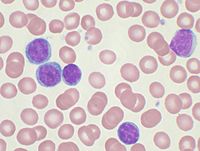
Photo from wikipedia
Objective: Generalized lymphatic anomaly (GLA), Gorham-Stout disease (GSD), kaposiform lymphangiomatosis (KLA), and central conducting lymphatic anomaly (CCLA) are rare, multisystem lymphatic disorders, referred to as complex lymphatic anomalies (CLAs). Their… Click to show full abstract
Objective: Generalized lymphatic anomaly (GLA), Gorham-Stout disease (GSD), kaposiform lymphangiomatosis (KLA), and central conducting lymphatic anomaly (CCLA) are rare, multisystem lymphatic disorders, referred to as complex lymphatic anomalies (CLAs). Their etiology remains poorly understood; however, somatic activating mutations have recently been discovered, and the results of targeted treatments are promising. This study aimed to elaborate on the phenotypic description of CLA. Methods: Thirty-six consecutive patients were recruited for the "GLA/GSD Registry" of the University Hospital of Freiburg, Germany (2015-2021). Clinical data were prospectively collected provided that a signed informed consent form was obtained. The latest proposed diagnostic guidelines were retrospectively applied. Results: Thirty-two patients (38% males) were included in the study; 15 GLA, 10 GSD, 3 KLA, and 4 CCLA patients were identified. Eighty-four percent already had symptoms by the age of 15 years. Osteolysis and periosseous soft-tissue infiltration were associated with GSD (p < 0.001 and p = 0.011, respectively), ascites and protein-losing enteropathy with CCLA (p = 0.007 and p = 0.004, respectively), and consumption coagulopathy with KLA (p = 0.006). No statistically significant differences were found in organ involvement, distribution of osteolytic lesions, number of affected bones and fractures. Twenty-five patients had complications; one patient with GLA died despite multimodal treatment. Spontaneous regression was seen in one patient with untreated KLA. Conclusions: CLA are rare, and their overlapping clinical presentations make differential diagnosis difficult. The characterization of our case series contributes to the phenotypic description and differentiation of these four clinical entities. A further understanding of their pathogenesis is crucial for evaluating targeted therapies and optimizing medical care.
Journal Title: Lymphatic research and biology
Year Published: 2023
Link to full text (if available)
Share on Social Media: Sign Up to like & get
recommendations!